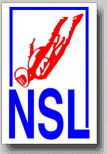
National
Skydiving
League
226 Pecan Street
Deland FL 32724
tel: (386) 801-0804
© 2003 - 2025
All Rights Reserved


226 Pecan Street
Deland FL 32724
tel: (386) 801-0804
© 2003 - 2025
All Rights Reserved

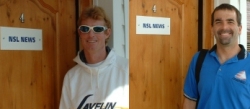
The NSL News met with Niklas Hemlin and John Hart at SkyVenture Orlando on July 15 when Fastrax resumed the training after the trip to Russia. The first NSL News interview with Fastrax took place at the same location and was posted with the NSL News on January 22. The follow-up story came after the observation of a Fastrax training day in Lake Wales on March 9.
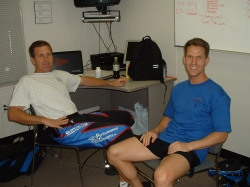
NSL News: John, Niklas, last time we met here at the same location was for an NSL News interview that was posted in January 2005. You laid out the big plans Fastrax had for the 2005 season. The NSL News followed up and observed a Fastrax training day in March in Lake Wales. Next was the FSL Shamrock Showdown 2005 with an average performance for the team.
Niklas Hemlin: The goal for the Shamrock was a 19 average. We ended up short of that. But we felt we were still on track even though we did not perform and deliver in the competition itself.
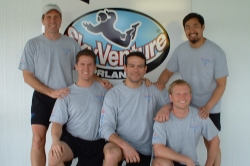
Niklas Hemlin: I think what happened was emotional and psychological growth, maturity. I think that we matured as a team and a project. Technically we have been a competent team. If we fly in the tunnel, in the air, with the exits - we have the block times, we have the random speed. The team just started to grow and started to believe. We have been working more and more with Dr. John, John deRosalia, which has helped. I would contribute the progression mostly to this maturity and the emotional and psychological growth.
NSL News: The training day in Lake Wales observed by the NSL News was showing the intense training regiment of Team Fastrax. People would think that it is crazy to make 35 jumps on a day. How do you look back at the Fastrax training now. Was that a part of the success?
John Hart: Absolutely. Our training program today is different than it was in Lake Wales. Then it was like: let's really hit the blocks, get the performance standards up to where they need to be, the technical side. Today we don't do the 35 jumps any longer, we do 15 to 20 and slowed the pace down. We are really focusing now on quality, space management, things like that. But at that time it was a very valuable part of where we are at today.
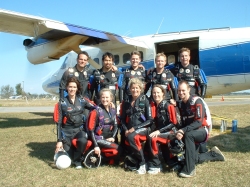
Niklas Hemlin: Two things happened to us. The first two jumps were kind of insigificant to us. I don't think a single meet in skydiving history was won by the first two rounds. So it doesn't matter if you are first or fifth. You can still win the meet if you are in fifth, and you can lose it when you are in first place after two rounds. I think the most sigificant thing for us was round two when we ended up with 19 points on the scoreboard. We made a big mistake on the first page, and we thought that we would lose several points. When we watched the other videos and saw the other scores it was almost reaffirming for us that we can make a mistake and lose only one point to the top teams. With that newly gained confidence and momentum we stepped into round three, knowing first of all that this is a Fastrax round. Secondly, it was a make it or break it. It would separate the men from the boys. We went into round three with a good attitude and the confidence from round two and swapped out a good round.
John Hart: Round two surely was a confidence builder. It was my glitch, and it cost us one or two points. But we could have won the round without the mistake. So, next round was our round, it was a Fastrax dive, it was where we do best. And we just went out and put it together, it was a very possible thing to do.
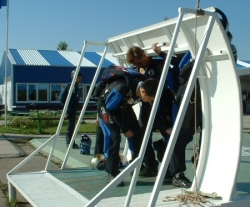
Niklas Hemlin: It started again on day two when we did rounds four and five. We were gaining momentum, and we were skydiving really well, we were right on track. Going into round six on the third day, we found out that we went too fast too soon. We were too overconfident. Round one was kind of slow, in round two we saw that we have what it takes. We steadily progressed through rounds three, four and five and skydived better and better and better. In round six we stepped over the egde. We were trying to skydive even better, even faster, even more confident, and we kind of shot ourselves in the foot. When we landed from round six, we all knew what happened. We said, okay, let's take it back half a notch, and let's do what we did in round five. That's how we came out to do round seven and eight. There we found our zone, and you can see us skydiving the way we did in rounds three, four and five.
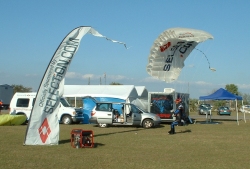
John Hart: It felt great. We put ourselves in that position by training hard and getting in there. I would not say that it was unexpected since we knew what we were capable of, but it still felt good to be there, no question about it.
NSL News: The position was kind of confirmed in round nine, Fastrax was still tied in second place. It was obvious now that you were a part of the top game. Then came round ten. Was the new pressure to much? What happened?
Niklas Hemlin: Nerves. Period. You cannot say anything else. Round ten was a Fastrax skydive, as was round three. That was a skydive that we were supposed to run away with. I expected nothing less than us to tie the highest score of the round, if not even win it. We had nerves, and we choked. Even though we got there with confidence, it was our first major competition. We went there to achieve a couple of things. The team goal was to break the 20-average. The second goal was to prove to the skydiving community that we are for real, not only a fake. We are here, we worked hard, we are talented, and we will do something unprecedented. All that came down to one moment of truth, and that's what happened in round ten.
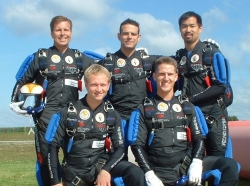
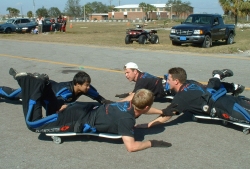
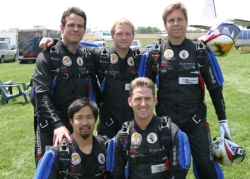
John Hart: It was huge for us. Of course, it was a fast draw, and Airspeed did a 22.8 average, as well. But it is what it is, you still have to perform and put the scores on the board. We knew what we were capable of, and these MESL scores added to the confidence. We knew we could match the scores of any team in the world now. It felt great.
Niklas Hemlin: People also have to realize that if you do competitions, you do not prepare to do well in competitions in January or February. You train to peak toward the end of the season. You train certain elements of your performance in the early stages. The 16 average at the earlier MESL meet does not represent anything. We were not worried at all at that time.
John Hart: Some parts of the training are still ahead of us. That's why we are here at the wind tunnel right now. There are still parts where we want to become stronger.

John Hart: I would say that we are right on target.
Niklas Hemlin: I would not say we are ahead of the game. You cannot be ahead of the game, even if ended up doing a 21 average at the Malevsky Cup. We are on track, and we are definitely not behind.
NSL News: Let's look ahead. Have the results of the Malevsky Cup changed any of your expectations for the remainder of the season when looking at yourself and at the contenders?
Niklas Hemlin: There are no news. Everything has been confirmed. Now it's all out there, our scores and the others are posted on the scoreboard. We are with all the other teams. We want to do our best, and we want to win. New is only what we learned for ourselves at the Malevsky Cup.
NSL News: Was there any round at the Malevsky Cup where any strategy became relevant and was used?
Niklas Hemlin: We decided to step back a bit in round six. That was kind of a strategic move. But we did not really talk strategy in any of the rounds. There was an engineering decision to be made for round seven, and we decided to do it conservatively over efficiency and speed. We ended up tying the highest score. We try not to look too much at the scores and standings of the other contenders.
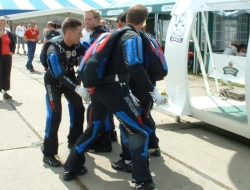
John Hart: Not necessarily in beating the other teams. We go to the competition to do the best we can. We compete more against ourselves. We have a strategy that works for us, and we have to follow this strategy. We know where our strenghts are, we know where the weaknesses are. We count a lot on the strength, and we have to avoid going beyond. That's what happened at the meet. We will stick to our strategy to build momentum and go. This is not going to change.
NSL News: What's the Fastrax road map from here to Perris? Which scoring average do you expect there for the winner? Will it be Majik level as last year? Higher? Lower?
Niklas Hemlin: We will score 21+ average on a medium draw. We would have broken the 20-average already at the Malevsky Cup with a medium round ten. With a medium performance in round six, we would have been close to a 21-average. That is just cleaning up some of the major mistakes we had. We will do 350 to 400 training jumps, and we have additional six or seven tunnel hours at SkyVenture Orlando. I am confident that this will guarantee the 21+ average. However, I don't think that the winner will score on DeLand Majik's 2004 level.
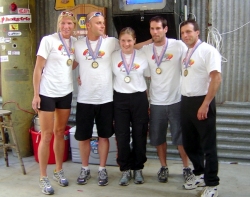
Niklas Hemlin: We have a total of seven weeks. We will use three weeks for a drill phase where we practice whatever we feel we should. The last three weeks we will do ten jumps per day on three or four days per week. These jumps will be purely competition draws, one draw per day with full preparation.
John Hart: Dan BC has been very helpful for us on the emotional side of the preparation. He commented recently: "You have proved that you can match any team in the world, at any jump, point for point. This experience will make you stronger and more capable of dealing at the best performance at any time. For round one to round ten, on the first day or the last, at sunrise or sunset, you can do it." That's what the Malevsky Cup has done for us. It was an awesome training tool. It included a heartbreak, which was important for us. There is nothing wrong with loosing a battle because the war is what you ultimately go out for. It put a lot of things in perspective, too. We look at all the dollars that were spent, all the personal sacrifice, the heartache being away from the family, the pain that goes into the hard training, the injuries and working through the injuries. Ultimately, none of this matters. When you go out there to an international competition thinking that you got all of this on the line, it is a lot of pressure. Ultimately, that's not what is important. It is important to go out and do your best, have fun. That's what we experienced at the Malevsky, as well.

John Hart: I would say it was a distraction. But I did my best to work with it. The team was very supportive with it. We knew it would be a distraction, not a negative distraction, but still a distraction. I am glad they were there, they are my greatest fans. They have always supported me through my military experiences and skydiving. I did not want them to miss the opportunity to visit a country like Russia. It was an awesome experience for them. The heartache they felt from the loss was just as great. They were in tears, they wanted us to win. They are very proud of the team, the team members are brothers to them. When I take my family to the nationals, it is not part of the plan. We will stick with our routine in Perris, we train alone, and we will compete alone. This was a once-in-a-lifetime opportunity possibly for my family to see Russia.
Niklas Hemlin: When it comes to John's family in Russia, it was kind of training of distraction control. As John said, positive or negative distraction - by the end of the day you need to do your job. You can never control all the elements. That itself was a good practice.
NSL News: Thank you for the interview, Niklas, John.